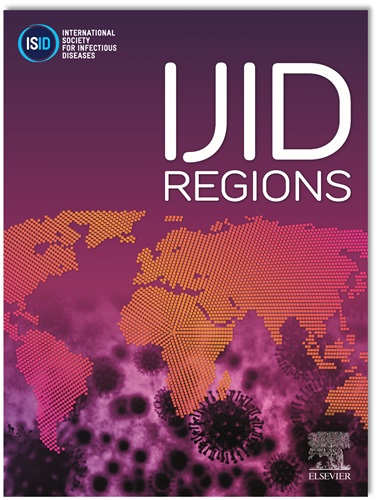Early bacterial pathogen distribution and risk factors for infections after liver transplantation: Retrospective cohort study
IF 4.3
2区 医学
Q1 INFECTIOUS DISEASES
引用次数: 0
Abstract
Objectives
To provide a comprehensive analysis of the epidemiological characteristics and clinical features of pathogens and explore the risk factors for post-liver transplant (LT) bacterial infections.
Methods
A retrospective analysis was conducted at Xiang’an Hospital of Xiamen University and the First Affiliated Hospital of Zhengzhou University between 2021 and 2024. Binary logistic regression analysis was performed to identify independent risk factors, including clinical characteristics and genetic polymorphisms related to infections within the first month after LT.
Results
Two hundred forty-two LT donors and recipients were included. Klebsiella pneumoniae (19.0%) was the most common gram-negative bacterium, whereas Staphylococcus aureus (7.1%) was the predominant gram-positive pathogen. A respiratory tract infection was the most common bacterial infection. Binary logistic regression analysis revealed that the recipient SLCO1B1 rs4149015 AA genotype, preoperative hypertension, and low preoperative red blood cell count were independent risk factors for post-LT infection in recipients.
Conclusion
Our analysis revealed the risk factors and clinical manifestations of bacterial infections as well as their polymorphisms. These findings provide valuable insights into the early detection and prevention of bacterial infections, revealing potential avenues for the development of methods to prevent such infections and therefore improve patient prognosis after LT.
肝移植术后感染的早期细菌病原体分布及危险因素:回顾性队列研究
目的综合分析肝移植术后病原菌的流行病学特征和临床特点,探讨肝移植术后细菌感染的危险因素。方法回顾性分析厦门大学翔安医院和郑州大学第一附属医院2021 - 2024年的临床资料。采用二元logistic回归分析确定与肝移植术后1个月内感染相关的临床特征和遗传多态性等独立危险因素。结果纳入242例肝移植供体和受体。最常见的革兰氏阴性菌为肺炎克雷伯菌(19.0%),革兰氏阳性菌为金黄色葡萄球菌(7.1%)。呼吸道感染是最常见的细菌感染。二元logistic回归分析显示,受体SLCO1B1 rs4149015 AA基因型、术前高血压、术前低红细胞计数是受体lt后感染的独立危险因素。结论揭示了细菌感染的危险因素、临床表现及其多态性。这些发现为早期发现和预防细菌感染提供了有价值的见解,揭示了开发预防此类感染的方法的潜在途径,从而改善肝移植后患者的预后。
本文章由计算机程序翻译,如有差异,请以英文原文为准。
求助全文
约1分钟内获得全文
求助全文
来源期刊
CiteScore
18.90
自引率
2.40%
发文量
1020
审稿时长
30 days
期刊介绍:
International Journal of Infectious Diseases (IJID)
Publisher: International Society for Infectious Diseases
Publication Frequency: Monthly
Type: Peer-reviewed, Open Access
Scope:
Publishes original clinical and laboratory-based research.
Reports clinical trials, reviews, and some case reports.
Focuses on epidemiology, clinical diagnosis, treatment, and control of infectious diseases.
Emphasizes diseases common in under-resourced countries.

 求助内容:
求助内容: 应助结果提醒方式:
应助结果提醒方式:


